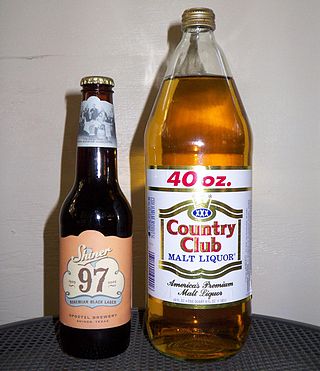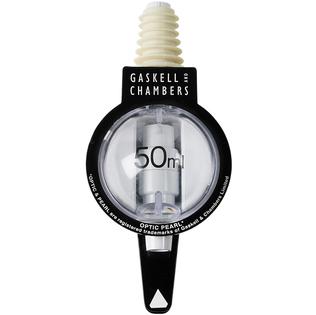
Irn-Bru is a Scottish carbonated soft drink, often described as "Scotland's other national drink". Introduced in 1901, the drink is produced in Westfield, Cumbernauld, North Lanarkshire, by A.G. Barr of Glasgow.

Whisky or whiskey is a type of liquor made from fermented grain mash. Various grains are used for different varieties, including barley, corn, rye, and wheat. Whisky is typically aged in wooden casks, which are typically made of charred white oak. Uncharred white oak casks previously used for the aging of port, rum or sherry are also sometimes used.

Alcohol proof is a measure of the content of ethanol (alcohol) in an alcoholic beverage. The term was originally used in England and was equal to about 1.8 times the percentage of alcohol by volume (ABV). The UK now uses ABV instead of proof. In the United States, alcohol proof is defined as twice the percentage of ABV. The definition of proof in terms of ABV varies from country to country.

A bar, also known as a saloon, a tavern or tippling house, or sometimes as a pub or club, is a retail business establishment that serves alcoholic beverages, such as beer, wine, liquor, cocktails, and other beverages such as mineral water and soft drinks. Bars often also sell cigarettes from a cigarette machine, snacks, such as crisps or peanuts, for consumption on their premises. Some types of bars, such as pubs, may also serve food from a restaurant menu. The term "bar" refers to the countertop where drinks are prepared and served, and by extension to the overall premises.

A shot glass is a glass originally designed to hold or measure spirits or liquor, which is either imbibed straight from the glass or poured into a cocktail. An alcoholic beverage served in a shot glass and typically consumed quickly, in one gulp, may also be known as a "shooter".

Malt liquor is a type of mass market beer with high alcohol content, most closely associated with North America. Legally, it often includes any alcoholic beverage with 5% or more alcohol by volume made with malted barley. In common usage, it refers to beers containing a high alcohol content, generally above 6%, which are made with ingredients and processes resembling those for American-style lagers.

Liquor is an alcoholic drink produced by the distillation of grains, fruits, vegetables, or sugar that have already gone through alcoholic fermentation. Other terms for liquor include: spirit, distilled beverage, spirituous liquor or hard liquor. The distillation process concentrates the liquid to increase its alcohol by volume. As liquors contain significantly more alcohol (ethanol) than other alcoholic drinks, they are considered "harder"; in North America, the term hard liquor is sometimes used to distinguish distilled alcoholic drinks from non-distilled ones, whereas the term spirits is more common in the UK. Some examples of liquors include vodka, rum, gin, and tequila. Liquors are often aged in barrels, such as for the production of brandy and whiskey, or are infused with flavorings to form flavored liquors, such as absinthe.

Container-deposit legislation is any law that requires the collection of a monetary deposit on beverage containers at the point of sale and/or the payment of refund value to the consumers. When the container is returned to an authorized redemption center, or retailer in some jurisdictions, the deposit is partly or fully refunded to the redeemer. It is a deposit-refund system.

Various unique terminology is used in bartending.

Glassing is a physical attack using a glass or bottle as a weapon. Glassings can occur at bars or pubs where alcohol is served and such items are readily available. The most common method of glassing involves the attacker smashing an intact glass vessel in the face of the victim, though it can also be smashed onto a surface, then gripped by the remaining base of the glass or neck of the bottle with the broken shards protruding outwards.
A liquor license is a governmentally issued permit to sell, manufacture, store, or otherwise use alcoholic beverages.

A drinking establishment is a business whose primary function is the serving of alcoholic beverages for consumption on the premises. Some establishments may also serve food, or have entertainment, but their main purpose is to serve alcoholic beverages. There are different types of drinking establishment ranging from seedy bars or nightclubs, sometimes termed "dive bars", to 5,000 seat beer halls and elegant places of entertainment for the elite. A public house, informally known as a "pub", is an establishment licensed to serve alcoholic drinks for consumption on the premises in countries and regions of British influence. Although the terms are increasingly used to refer to the same thing, there is a difference between pubs, bars, inns, taverns and lounges where alcohol is served commercially. A tavern or pot-house is, loosely, a place of business where people gather to drink alcoholic beverages and, more than likely, also be served food, though not licensed to put up guests. The word derives from the Latin taberna and the Greek ταβέρνα/taverna.

An alcoholic beverage is a drink that contains ethanol, a type of alcohol that acts as a drug and is produced by fermentation of grains, fruits, or other sources of sugar. The consumption of alcoholic drinks, often referred to as "drinking", plays an important social role in many cultures. Most countries have laws regulating the production, sale, and consumption of alcoholic beverages, and the temperance movement advocates against the consumption of alcoholic beverages. Regulations may require the labeling of the percentage alcohol content and the use of a warning label. Some countries ban such activities entirely, but alcoholic drinks are legal in most parts of the world. The global alcoholic drink industry exceeded $1 trillion in 2018.

Alcoholic spirits measures are instruments designed to measure exact amounts or shots of alcoholic spirits.

Cacique Guaro is a brand of guaro produced by Fábrica Nacional de Licores or "FANAL". Cacique Guaro is a sugar cane-based liquor of high purity and is the best-selling distilled spirit in Costa Rica. It is known as "Costa Rican liqueur". As it has a neutral taste, guaro can be consumed pure or combined with any natural or artificial mixing.

A fifth is a unit of volume formerly used for wine and distilled beverages in the United States, equal to one fifth of a US liquid gallon, or 25+3⁄5 U.S. fluid ounces ; it has been superseded by the metric bottle size of 750 ml, sometimes called a metric fifth, which is the standard capacity of wine bottles worldwide and is approximately 1% smaller.

Royal Stag, also known as Seagram's Royal Stag, is an Indian whisky launched in 1995. It is available in many countries across the world in various pack sizes. It is Pernod Ricard's best selling brand by volume. It is a blend of grain spirits and imported Scotch malts. It is commonly available in 1 L, 750 mL, 375 mL and 180 mL bottles and also available in 90 mL and 60 mL bottles. The brand is named after a species of deer famous for its antlers, that is also featured in its logo. It is produced in several company-owned as well as bottler-owned distilleries. It was the first whisky brand launched in India that did not use any artificial flavours.
Signature, also known as McDowell's Signature, is a brand of Indian whisky, manufactured by United Spirits Ltd (USL), a Diageo Group company. It was launched in 1994. Signature is a blend of imported Scotch whisky and locally produced products. Signature is sold in octagonal bottles which were designed by London-based design firm Claessens International, who also designed the packaging of the bottle. It is available in two variants – Signature Rare Aged and Signature Premier Grain.

Huangjiu is a type of Chinese alcoholic beverage most popular in the Jiangnan area. Huangjiu is brewed by mixing boiled grains including rice, glutinous rice or millet with qū as starter culture, followed by saccharification and fermentation at around 13–18 °C (55–64 °F) for fortnights. Its alcohol content is typically 8% to 20%.


















